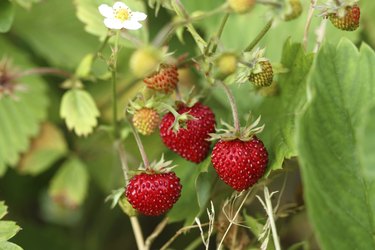
Strawberries (Fragaria ananassa) are winter hardy in U.S. Department of Agriculture plant hardiness zones 3 to 9, depending on cultivar, and will grow reliably as perennials throughout Missouri, where the climate ranges from USDA zone 5b in the north to zone 7 in the Bootheel region. Planting strawberries early in the spring will ensure that new plants get well established in their first season and produce berries the following year.
Varieties for Missouri
Video of the Day
June-bearing strawberry cultivars bear a single large crop of berries each season. Cultivars of this type recommended for planting in Missouri include "Honeoye," hardy in USDA zones 3 to 8; "Redchief," hardy in USDA zones 3 to 9; and "Allstar," "Earliglow" and "Jewel," all hardy in USDA zones 4 to 8.
Video of the Day
Day-neutral cultivars are a type of ever-bearing strawberry that has the potential to flower and produce fruit throughout the growing season; their flowering is not triggered by the length of the day as is that of June-bearing cultivars. Day-neutral cultivars suitable for Missouri include "Tribute" and "Tristar," both hardy in USDA zones 4 to 8.
Site Requirements
To produce well, strawberries need 8 hours or more of full sun per day, and they'll do even better if they get 10 hours or more each day. Keep them out of the shade cast by structures, and keep them away from the root zones of trees that will draw soil nutrients and water away from them.
Strawberries need soil that drains well but retains enough moisture to prevent the plants from drying out, and they also prefer slightly acidic soil, with a pH level between 5.3 and 6.5. If your soil pH is higher than that, which is common in parts of Missouri where limestone is prevalent in the ground, you may be able to lower it sufficiently with amendments; adding 2 pounds of elemental sulfur per 100 square feet of planting area, mixing the sulfur into the top foot of soil, will lower the soil's pH by one point over a period of about six months.
Site Considerations
Weed- and disease-free sites are required for proper growth and health of strawberry plants. Areas that have recently had sod cleared from them are not recommended due to lingering grubs, diseases and perennial weed seeds in the soil. White lawn grubs will destroy strawberry crops. It's best to clear the planting site of weeds or grass weeks if not several months before planting and keeping the area clean while waiting to plant.
Unless planting strawberry cultivars resistant to verticillium wilt, do not plant the berries in sites where member of the Solanaceae family were grown. Non-resistant cultivars are susceptible to being affected by this soil-borne disease.
Soil Amendments and Preparation
If your planting bed soil is sandy and doesn't retain water well, incorporating up to 4 inches of composted organic material will improve the soil's water retention. Adding the same organic material will also help to lighten the texture of dense clay soil and improve the soil's drainage. In general, sandy soils are more common in the Bootheel region, and the northern and western regions of Missouri tend to have heavier soils; soil types in other parts of the state vary.
Strawberries will also benefit from fertilization at planting time. Mix a 5-10-5 or 8-24-8 fertilizer into the planting bed, using a pound of fertilizer for each 100 square feet of planting area. Dig it approximately 6 inches into the soil.
Planting Process
In Missouri, plant strawberries as soon as the soil is workable in the spring, typically in March or early April.
Keep strawberry roots moist but not soggy, if holding for a week or two before planting. Do not allow the roots to dry out. Sterilize pruning tools by wiping the blades off with alcohol and allowing to dry, and trim off any damaged roots or those longer than 5 inches before planting. If possible, plant the strawberries on a cloudy day that is cool to alleviate the most transplanting stress
Proper planting depth is one of the most important parts of successfully growing strawberries. If the plant's crown, where the leaves emerge from the root system, is buried, the crown is likely to rot. If, however, the roots are exposed, they will probably dry out and be damaged. Set the plants so that the level of the soil is at the middle of the crown. Spread the roots out to resemble a fan and have them pointed downward and not bunched together.
Space plants 30 to 36 inches apart, and space rows 42 to 48 inches apart. Firm soil around the plants after they're set.
Water them thoroughly at planting and give them about an inch of water per week thereafter.
- Missouri Botanical Garden: Fragaria 'Allstar'
- University of Missouri Extension: Strawberry Cultivars and Their Culture
- University of Minnesota Extension: Strawberries for the Home Garden
- Missouri Botanical Garden: Soil pH
- Purdue University: Missouri Vegetable Crops
- Indiana Berry & Plant Co.: Strawberry Varieties